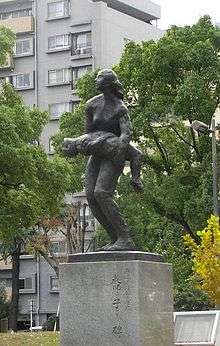Shinoe Shōda

Shinoe Shōda (正田 篠枝 Shōda Shinoe, December 1910 – 15 June 1965) was a Japanese poet and author known for her atomic bomb literature.
Shōda was born in Etajima in Hiroshima Prefecture in 1910.[1] Around 1920 her family moved to Ujina, just outside Hiroshima, and in 1925 she enrolled in a Jōdo Shinshū girls' high school, graduating in 1929.[1]
In the late 1920s she started publishing poetry in Kōran, a monthly literary magazine.[1]
Shōda married engineer Takamoto Suematsu and the two had a son, Shin'ichirō.[1] In 1940 her husband died and in 1945 her family home was destroyed, forcing the family to move into the city of Hiroshima.[1] On August 6, 1945, the city was devastated by the atomic bomb attack. Shōda's home at that time was only two kilometers from ground zero.[1] By February of the next year her father had died of intestinal cancer and later her son also fell ill.[1]
Following Japan's surrender, Shōda started writing traditional tanka poetry on the theme of the atomic bombing.[1] She had difficulty publishing both because of the subject and because of her relative lack of experience.[1] In 1946 she succeeded in publishing 39 of her poems in the journal Fuschichō.[1] In 1947, evading Occupation censorship, she secretly published Sange ("Penitence" or "Repentance"), a tanka anthology.[1][2][3] 150 copies of the book were mimeographed by a clerk at the Hiroshima prison and Shōda personally distributed it to victims of the blast.[4][5]
She published little after Sange until the 1960s when, in 1962 she published a memoir, A Ringing in the Ears.[1] Shortly after its publication she fell ill with breast cancer and her health deteriorated rapidly.[1] She died on 15 June 1965,[1] the year before the publication of her second tanka collection, Sarusuberi ("Crape myrtle"), published in 1966. "Reiko" along with "Chanchako bachan" ("Old woman in chanchako, or a padded sleeveless jacket”), was posthumously published in Dokyumento Nihonjin ("Document of the Japanese") in 1969. Pikakko-chan contains seven stories, including “Reiko” and "Chanchako bachan".[6]
One of her poems from Sange appears on the Monument of the A-bombed Teachers and Students of National Elementary Schools in Hiroshima.[1]
References
- 1 2 3 4 5 6 7 8 9 10 11 12 13 14 15 Treat, John Whittier (1996). Writing Ground Zero: Japanese Literature and the Atomic Bomb. University of Chicago Press. pp. 189–197. ISBN 9780226811789.
- ↑ Kenzaburo Oe; Kenzaburō Ōe; David L. Swain; Toshi Yonezawa (1996). Hiroshima Notes. Grove Press. p. 165. ISBN 9780802134646.
- ↑ Masamoto Nasu (1991). Children of the Paper Crane. M.E. Sharpe. p. 98. ISBN 9780873327169.
- ↑ "Social Damages". AtomicBombMuseum.org. 2006. Retrieved 19 July 2012.
- ↑ Kaushik, Devendra (1970). Under the Mushroom Cloud of Death. Rachna Publishers. p. 17.
- ↑ Roach Pierson, Ruth (1987). Women and peace: theoretical, historical, and practical perspectives. Croom Helm. p. 227. ISBN 978-0-7099-4068-5.